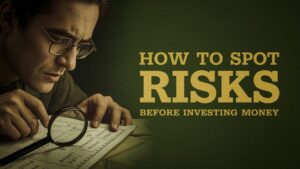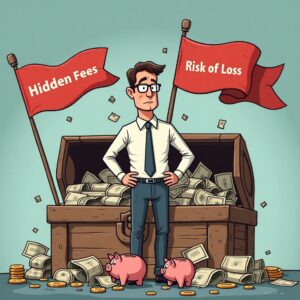
# **How to Spot Risks Before Investing Money: A Complete Guide**
### **Introduction**
Investing is one of the most effective ways to grow wealth, beat inflation, and secure your financial future. However, every investment carries risk. From market crashes to company bankruptcies, from economic downturns to fraud—investors must be vigilant.
**Spotting risks before investing** is not just a good habit—it’s a necessity. This guide will equip you with the knowledge and tools to assess and identify different types of investment risks so you can make informed decisions, protect your capital, and improve your long-term returns.
—
**1. Understanding Investment Risk**
### **What Is Investment Risk?**
Investment risk refers to the possibility of losing part or all of the money you invest, or not achieving your expected return. The degree of risk varies depending on the asset, the market, and external conditions.
Common Types of Risk:
* **Market Risk** – Losses due to overall market movements
* **Credit Risk** – Default by borrowers or companies
* **Liquidity Risk** – Inability to sell assets quickly without loss
* **Inflation Risk** – Erosion of purchasing power over time
* **Currency Risk** – Fluctuations in foreign exchange rates
* **Interest Rate Risk** – Changes in rates affecting bond values
* **Operational Risk** – Failures within a company’s system or process
* **Fraud Risk** – Exposure to scams, misrepresentation, or deception
—
**2. Risk vs. Reward: Balancing the Equation**
Before diving into how to spot risks, it’s essential to understand the

**risk-return tradeoff**: generally, higher potential returns come with higher risks. Successful investors don’t avoid risk—they **understand and manage it**.
Ask Yourself:
* What is my **risk tolerance**?
* What is my **investment goal** and **time horizon**?
* How much loss am I willing to accept to achieve higher returns?
—
## **3. How to Spot Risks Before Investing**
### **Step 1: Perform Fundamental Analysis**
**Fundamental analysis** helps evaluate the true value and financial health of an asset, usually a company.
Check:
* **Financial Statements** (Balance Sheet, Income Statement, Cash Flow)
* **Debt Levels** (High debt = higher risk)
* **Revenue Growth** (Stable and consistent is best)
* **Profit Margins** (Declining margins can signal trouble)
* **Return on Equity (ROE)** – Measures efficiency
* **Price-to-Earnings (P/E) Ratio** – High may mean overvaluation
If a company has unstable earnings, excessive debt, or inconsistent cash flow—it’s a red flag.
### **Step 2: Conduct Industry and Sector Analysis**
Different industries carry different levels of risk.
High-risk sectors:
* Biotech (dependent on approvals and R\&D)
* Startups/Tech (disruption, rapid change)
* Commodities (volatile pricing)
* Emerging markets (political/economic instability)
Lower-risk sectors:
* Utilities
* Consumer staples
* Healthcare (depending on the sub-sector)
Evaluate:
* Market demand trends
* Regulatory environment
* Competition
* Economic cycles
**Step 3: Analyze the Management Team**
Strong leadership is critical to a company’s success. Poor or unethical leadership is a major risk factor.
Look for:
* Track record and experience
* Corporate governance transparency
* Board independence
* Insider buying/selling trends
* History of litigation or regulatory issues
Red flags:
* Frequent CEO turnover
* Management involved in scandals
* Overpromising results with no execution
### **Step 4: Study Market Sentiment and News**
Market sentiment refers to how investors feel about a security or market at a given time.
Sources to track:
* Financial news (Bloomberg, Reuters, CNBC)
* Analyst reports and ratings
* Social media sentiment
* Investor forums (Reddit, Seeking Alpha)
Be cautious if:
* A stock is hyped without fundamental support
* Insider selling is heavy
* Rumors of investigations or class action lawsuits emerge
### **Step 5: Evaluate Valuation Metrics**
Overvalued stocks carry greater downside risk.
Key indicators:
* P/E Ratio: A high P/E relative to industry average may signal overvaluation.
* PEG Ratio: Considers growth; >1 may indicate overpricing.
* Price-to-Book (P/B): A high P/B may not be justified by asset value.
* Dividend Yield: Too high could be unsustainable.
Compare these metrics with industry benchmarks to avoid overpaying.
—
**4. Red Flags in Common Investment Vehicles**

### **A. Stocks**
* Inconsistent earnings growth
* Negative news around leadership or fraud
* Weak balance sheet or excessive debt
* Dependence on a single product or customer
### **B. Bonds**
* Low credit rating (junk bonds)
* High yield with no clear justification
* Issuer with a history of default or financial instability
### **C. Mutual Funds & ETFs**
* High expense ratio with poor performance
* Lack of transparency in holdings
* Over-concentration in risky sectors
* Poor historical management performance
### **D. Real Estate**
* Overpriced property relative to local market
* Poor location with low demand
* Legal or zoning issues
* Lack of liquidity or high maintenance costs
### **E. Cryptocurrencies**
* Lack of utility or real-world application
* Anonymous founders or unverified teams
* Unregulated exchanges
* Pump-and-dump patterns
—
**5. Use Risk Assessment Tools**
### **A. Credit Ratings**
For bonds or fixed income:
* **Moody’s, S\&P, Fitch** provide ratings from AAA (safe) to D (default)
### **B. Beta Coefficient**
Measures volatility relative to the market:
* Beta > 1: More volatile
* Beta < 1: Less volatile
* Beta = 1: Matches market movement
### **C. Sharpe Ratio**
Shows return per unit of risk:
* Higher Sharpe Ratio = Better risk-adjusted performance
### **D. Morningstar Risk Ratings**
Used for mutual funds and ETFs:
* Evaluates past volatility and fund management
### **E. Financial Ratios and Benchmarks**
Use screeners and platforms like:
* Yahoo Finance
* Finviz
* TradingView
* Bloomberg Terminal (for professionals)
—
**6. Psychological and Emotional Risks**

### **A. Herd Mentality**
Following others blindly without analysis can lead to losses.
### **B. Overconfidence Bias**
Overestimating your knowledge or ability to predict markets increases risk.
### **C. Loss Aversion**
Holding onto losing investments hoping they’ll recover can cause greater damage.
### **D. Confirmation Bias**
Only seeking information that supports your view and ignoring red flags is dangerous.
**Solution:** Stick to a plan, diversify, and review regularly with objectivity.
—
**7. The Importance of Diversification**
Diversification reduces overall portfolio risk by spreading investments across asset classes, sectors, and geographies.
Guidelines:
* Don’t put more than 10% into a single stock.
* Combine equities, bonds, real estate, and commodities.
* Diversify across industries (tech, health, finance).
* Use ETFs or mutual funds to access broader markets.
Diversification doesn’t eliminate risk, but it **helps manage and contain it**.
—
**8. Understand the Macro Environment**

Economic indicators can signal risks to your investments.
Watch for:
* Interest rate hikes (impact bonds and high-growth stocks)
* Inflation trends
* Unemployment rates
* GDP growth/decline
* Global political instability
Example: Rising inflation erodes real returns, while rate hikes make borrowing expensive—affecting corporate earnings and stock prices.
—
**9. Regulatory and Legal Risks**
Before investing, ask:
* Is the investment regulated by SEC, FINRA, FCA, or other bodies?
* Are the brokers or platforms licensed and insured?
* Is there legal recourse in case of fraud?
Unregulated schemes like Ponzi schemes, off-shore offerings, or too-good-to-be-true returns often carry **massive fraud risk**.
Do your due diligence:
* Verify credentials on official government websites.
* Avoid pressure tactics or promises of “guaranteed” returns.
—
**10. Create a Personal Risk Management Plan**
### Step-by-Step:
1. **Define Goals** – Retirement? Income? Capital appreciation?
2. **Assess Your Risk Tolerance** – Conservative, moderate, aggressive?
3. **Choose the Right Mix** – Based on your risk profile.
4. **Use Stop-Loss Orders** – Especially in volatile investments.
5. **Rebalance Portfolio Periodically** – To maintain your strategy.
6. **Keep an Emergency Fund** – 3–6 months of expenses in liquid assets.
7. **Avoid Leverage** – Borrowing to invest increases risk significantly.
—
**11. Learn from Real-World Failures**

### Case Studies:
**Enron (2001):**
* Risk Ignored: Fraudulent accounting, overreliance on stock value
* Lesson: Even big companies can collapse due to unethical practices
**Lehman Brothers (2008):**
* Risk Ignored: High leverage and subprime mortgage exposure
* Lesson: Know what you’re investing in and the bigger market context
**FTX (2022):**
* Risk Ignored: Lack of regulatory oversight and transparency
* Lesson: Avoid unregulated assets with unclear business models
—
**12. Questions to Ask Before Any Investment**
* What do I know about this company/product?
* What are the potential downsides?
* Is this asset priced fairly?
* What are the macro risks?
* Is this too good to be true?
* How easily can I exit?
* Am I relying on hope or facts?
—
## **Conclusion**
No investment is without risk. But understanding how to identify and evaluate these risks **before investing** can be the difference between success and failure. From financial health checks and industry analysis to psychological control and diversification—managing risk is about being **informed**, **disciplined**, and **vigilant**.
Make it your habit to do thorough research, consult with financial advisors if necessary, and always approach every investment with a clear strategy and a healthy dose of skepticism. Smart investing isn’t just about chasing returns—it’s about **preserving capital** and **growing it sustainably**.
—